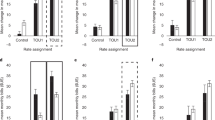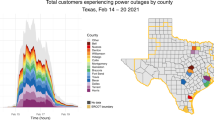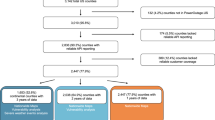Abstract
Climate-induced extreme weather events, as well as other natural and human-caused disasters, have the potential to increase the duration and frequency of large power outages. Resilience, in the form of supplying a small amount of power to homes and communities, can mitigate outage consequences by sustaining critical electricity-dependent services. Public decisions about investing in resilience depend, in part, on how much residential customers value those critical services. Here we develop a method to estimate residential willingness-to-pay for back-up electricity services in the event of a large 10-day blackout during very cold winter weather, and then survey a sample of 483 residential customers across northeast USA using that method. Respondents were willing to pay US$1.7–2.3 kWh–1 to sustain private demands and US$19–29 day–1 to support their communities. Previous experience with long-duration outages and the framing of the cause of the outage (natural or human-caused) did not affect willingness-to-pay.
This is a preview of subscription content, access via your institution
Access options
Access Nature and 54 other Nature Portfolio journals
Get Nature+, our best-value online-access subscription
$29.99 / 30 days
cancel any time
Subscribe to this journal
Receive 12 digital issues and online access to articles
$119.00 per year
only $9.92 per issue
Buy this article
- Purchase on Springer Link
- Instant access to full article PDF
Prices may be subject to local taxes which are calculated during checkout




Similar content being viewed by others
Data availability
The data that is directly used for the statistical tests in the results section and for generating Figs. 2–4 and Tables 1–3 can be found in Supplementary Data. The complete datasets that support the plots and other findings of this study are available in the Open Science Framework project page, https://osf.io/ugvqh/.
Code availability
The R code file written for the data analysis is available in the Open Science Framework project page, https://osf.io/ugvqh/.
References
National Academies of Sciences, Engineering, and Medicine Enhancing the Resilience of the Nation’s Electricity System (National Academies Press, 2017).
Narayanan, A. & Morgan, M. G. Sustaining critical social services during extended regional power blackouts. Risk Anal. 32, 1183–1193 (2012).
Baik, S., Morgan, M. G. & Davis, A. L. Providing limited local electric service during a major grid outage: a first assessment based on customer willingness to pay. Risk Anal. 38, 272–282 (2018).
Sullivan, M., Schellenberg, J. & Blundell, M. Updated Value of Service Reliability Estimates for Electric Utility Customers in the United States Report LBNL-6941E (Lawrence Berkeley National Lab, 2015).
Sullivan, M. J. & Keane, D. M. Outage Cost Estimation Guidebook Report EPRI-TR-106082 (Electric Power Research Inst., 1995).
Baik, S., Davis, A. L. & Morgan, M. G. Assessing the cost of large-scale power outages to residential customers. Risk Anal. 38, 283–296 (2018).
Schulze, W., McClelland, G., Waldman, D. & Lazo, J. in The Contingent Valuation of Environmental Resources: Methodological Issues and Research Needs (eds Bjornstad, D. J. & Kahn, J. R.) 97–116 (Edward Elgar, 1996).
Fischhoff, B. (1991). Value elicitation: is there anything in there? Am. Psychol. 46, 835–847 (1991).
Mishra, S. & Suar, D. Do lessons people learn determine disaster cognition and preparedness? Psychol. Dev. Societies 19, 143–159 (2007).
Mulilis, J. P., Duval, T. S. & Rogers, R. The effect of a swarm of local tornados on tornado preparedness: a quasi-comparable cohort investigation. J. Appl. Soc. Psychol. 33, 1716–1725 (2003).
Heller, K., Alexander, D. B., Gatz, M., Knight, B. G. & Rose, T. Social and personal factors as predictors of earthquake preparation: the role of support provision, network discussion, negative affect, age, and education. J. Appl. Soc. Psychol. 35, 399–422 (2005).
Sorensen, J. H. Knowing how to behave under the threat of disaster: can it be explained? Environ. Behav. 15, 438–457 (1983).
Palm, R. & Hodgson, M. Earthquake insurance: mandated disclosure and homeowner response in California. Ann. Assoc. Am. Geogr. 82, 207–222 (1992).
Paton, D., Smith, L. & Johnston, D. M. Volcanic hazards: risk perception and preparedness. New Zeal. J. Psychol. 29, 86–91 (2000).
Paton, D. & Johnston, D. Disasters and communities: vulnerability, resilience and preparedness. Disaster Prev. Manag. 10, 270–277 (2001).
Zhai, G., Sato, T., Fukuzono, T., Ikeda, S. & Yoshida, K. Willingness to pay for flood risk reduction and its determinants in Japan. J. Am. Water Resour. 42, 927–940 (2006).
Hoffmann, R. & Muttarak, R. Learn from the past, prepare for the future: impacts of education and experience on disaster preparedness in the Philippines and Thailand. World Dev. 96, 32–51 (2017).
Schultz, P. W. in New Tools for Environmental Protection: Education, Information, and Voluntary Measures (eds Dietz, T. and Stern, P.C.) 67–82 (National Academies Press, 2002).
Monroe, M. C., Pennisi, L., McCaffrey, S. & Mileti, D. Social Science to Improve Fuels Management: A Synthesis of Research Relevant to Communicating with Homeowners About Fuels Management (US Department of Agriculture, 2006).
Jepson, R. G., Harris, F. M., Platt, S. & Tannahill, C. The effectiveness of interventions to change six health behaviours: a review of reviews. BMC Public Health 10, 538–553 (2010).
Murphy, J. J., Allen, P. G., Stevens, T. H. & Weatherhead, D. A meta-analysis of hypothetical bias in stated preference valuation. Environ. Resour. Econ. 30, 313–325 (2005).
Schmidt, J. & Bijmolt, T. H. Accurately measuring willingness to pay for consumer goods: a meta-analysis of the hypothetical bias. J. Acad. Mark. Sci. 0, https://doi.org/10.1007/s11747-019-00666-6 (2019).
Curtis, J. A. & McConnell, K. E. The citizen versus consumer hypothesis: evidence from a contingent valuation survey. Aust. J. Agr. Resour. Econ. 46, 69–83 (2002).
Camerer, C. F. & Fehr, E. in Foundations of Human Sociality: Economic Experiments and Ethnographic Evidence from Fifteen Small-Scale Societies (eds Henrich, J. et al.) 55–95 (Oxford Univ. Press, 2004).
Levitt, S. D. & List, J. A. What do laboratory experiments measuring social preferences reveal about the real world? J. Econ. Perspect. 21, 153–174 (2007).
Donahue, A. K. Risky business: willingness to pay for disaster preparedness. Public Budg. Finance 34, 100–119 (2014).
Fischhoff, B., Slovic, P., Lichtenstein, S., Read, S. & Combs, B. How safe is safe enough? A psychometric study of attitudes towards technological risks and benefits. Policy Sci. 9, 127–152 (1978).
Slovic, P., Fischhoff, B. & Lichtenstein, S. Behavioral decision theory perspectives on risk and safety. Acta Psychol. 56, 183–203 (1984).
Englander, T., Farago, K., Slovic, P. & Fischhoff, B. A comparative analysis of risk perception in Hungary and the United States. Soc. Behav. 1, 55–66 (1986).
Brun, W. Cognitive components in risk perception: natural versus manmade risks. J. Behav. Decis. Making 5, 117–132 (1992).
Dziegielewski, S. F. & Sumner, K. An examination of the American response to terrorism: handling the aftermath through crisis intervention. Brief Treat. Crisis Intervention 2, 287–300 (2002).
Beutler, L. E., Reyes, G., Franco, Z. & Housley, J. in Psychology of Terrorism (eds Bongar, B., Brown, L. M., Beutler, L. E., Breckenridge, J. N. & Zimbardo P. G.) 32–55 (Oxford Univ. Press, 2007).
Renn, O. & Rohrmann, B. Cross-Cultural Risk Perception: A Survey of Empirical Studies (Springer Science & Business Media, 2000).
Baik, S., Davis, A. L. & Morgan, M. G. Illustration of a method to incorporate preference uncertainty in benefit–cost analysis. Risk Anal. 39, 2359–2368 (2019).
Sullivan, M. & Schellenberg, J. Downtown San Francisco Long Duration Outage Cost Study (Freeman, Sullivan & Company, 2013).
Corwin, J. L. & Miles, W. T. Impact Assessment of the 1977 New York City Blackout. Final Report HCP/T5103-01. (System Control, Inc., 1978).
Valuation of Energy Security for The United States (US Department of Energy, 2017); https://www.energy.gov/sites/prod/files/2017/01/f34/Valuation%20of%20Energy%20Security%20for%20the%20United%20States%20%28Full%20Report%29_1.pdf
Tversky, A. & Kahneman, D. Judgment under uncertainty: heuristics and biases. Science 185, 1124–1131 (1974).
Desvousges, W. H, Reed Johnson, F, Dunford, R. W, Nicole, W. K. & Boyle, K. J. in Contingent Valuation: A Critical Assessment (ed. Hausmann, J. A.) 91–164 (Emerald Group, 1993).
Hensher, D. A. Hypothetical bias, choice experiments and willingness to pay. Transp. Res. B 44, 735–752 (2010).
Morrissey, K., Plater, A. & Dean, M. The cost of electric power outages in the residential sector: a willingness to pay approach. Appl. Energ. 212, 141–150 (2018).
Bhatia, S. Associations and the accumulation of preference. Psychol. Rev. 120, 522–543 (2013).
Payne, J. W., Bettman, J. R. & Johnson, E. J. Adaptive strategy selection in decision making. J. Exp. Psychol. Learn. 14, 534–552 (1988).
Payne, J. W., Bettman, J. R., Schkade, D. A., Schwarz, N. & Gregory, R. in Elicitation of Preferences (eds Fischhoff, B. & Manski, C. F.) 243–275 (Springer, 1999).
Luce, R. D. & Suppes, P. in Handbook of Mathematical Psychology Vol. 3 (eds Luce, R. D. et al.) 249–409 (Wiley, 1965).
Davis-Stober, C. P. Analysis of multinomial models under inequality constraints: applications to measurement theory. J. Math. Psychol. 53, 1–13 (2009).
De La Maza, C., Davis, A., Gonzalez, C. & Azevedo, I. A graph-based model to discover preference structure from choice data. In Proc. 40th Annual Meeting of the Cognitive Science Society 25–28 (Cognitive Science Society, 2018).
Boxall, P. C., Adamowicz, W. L., Swait, J., Williams, M. & Louviere, J. A comparison of stated preference methods for environmental valuation. Ecol. Econ. 18, 243–253 (1996).
Mogas, J., Riera, P. & Bennett, J. A comparison of contingent valuation and choice modeling with second-order interactions. J. For. Econ. 12, 5–30 (2006).
Foster, V. & Mourato, S. Elicitation format and sensitivity to scope. Environ. Resour. Econ. 24, 141–160 (2003).
Jin, J., Wang, Z. & Ran, S. Comparison of contingent valuation and choice experiment in solid waste management programs in Macao. Ecol. Econ. 57, 430–441 (2006).
Arrow, K. et al. Report of the NOAA panel on contingent valuation. Fed. Register 58, 4601–4614 (1993).
List, J. A. & Gallet, C. A. What experimental protocol influence disparities between actual and hypothetical stated values? Environ. Resour. Econ. 20, 241–254 (2001).
Cubitt, R. P., Navarro-Martinez, D. & Starmer, C. On preference imprecision. J Risk Uncertainty. 50, 1–34 (2015).
Håkansson, C. A new valuation question: analysis of and insights from interval open-ended data in contingent valuation. Environ. Resour. Econ. 39, 175–188 (2008).
Bayrak, O. & Kriström, B. Is there a valuation gap? The case of interval valuations. Econ. Bull. 36, 218–236 (2015).
Dillman, D. A. & Smyth, J. D. Design effects in the transition to web-based surveys. Am. J. Prev. Med. 32, S90–S96 (2007).
Baik, S., Sirinterlikci, S., Park, J. W., Davis, A. & Morgan, M. G. in Frontiers in the Economics of Widespread, Long-duration Power Interruptions: Proceedings from an Expert Workshop (eds Larsen, P. H. et al.) Topic II (Lawrence Berkeley National Lab, 2019).
Messer, B. L. & Dillman, D. A. Surveying the general public over the internet using address-based sampling and mail contact procedures. Public Opin. Quart. 75, 429–457 (2011).
S. Siegel, Nonparametric Statistics for the Behavioral Sciences (McGraw-Hill, 1956).
Acknowledgements
The work was funded by the Center for Climate and Energy Decision Making through a cooperative agreement between the National Science Foundation (SES-0949710 and SES-1463492) and Carnegie Mellon University, Transmission Planning and Technical Assistance Division of the US Department of Energy’s Office of Electricity Delivery and Energy Reliability under Lawrence Berkeley National Laboratory contract no. DE-AC02–05CH1123, and by the Thomas Lord Chair, the Hamerschlag Chair and other academic funds from Carnegie Mellon University.
Author information
Authors and Affiliations
Contributions
M.G.M. and A.L.D. secured project funding; S.B., A.L.D. and M.G.M. designed the study; J.P. and S.S. developed and demonstrated the online survey framework; S.B., J.P. and S.S. conducted pilot tests; S.B. and J.P. conducted online surveys; S.B. analysed the data and created the figures and tables with iterative feedback from A.L.D. and M.G.M.; S.B., A.L.D. and M.G.M. drafted and edited the manuscript.
Corresponding author
Ethics declarations
Competing interests
The authors declare no competing interests.
Additional information
Publisher’s note Springer Nature remains neutral with regard to jurisdictional claims in published maps and institutional affiliations.
Supplementary information
Supplementary Information
Supplementary Figs. 1 and 2, Tables 1–10, Discussion, Method, Notes 1 and 2 and refs. 1–11.
Rights and permissions
About this article
Cite this article
Baik, S., Davis, A.L., Park, J.W. et al. Estimating what US residential customers are willing to pay for resilience to large electricity outages of long duration. Nat Energy 5, 250–258 (2020). https://doi.org/10.1038/s41560-020-0581-1
Received:
Accepted:
Published:
Issue Date:
DOI: https://doi.org/10.1038/s41560-020-0581-1
This article is cited by
-
Hurricane-Induced Power Disruptions: Household Preferences for Improving Infrastructure Resilience
Economics of Disasters and Climate Change (2024)
-
Buying electricity resilience: using backup generator sales in the United States to understand the role of the private market in resilience
Journal of Infrastructure Preservation and Resilience (2023)
-
Increase in frequency of nuclear power outages due to changing climate
Nature Energy (2021)
-
When the lights go out
Nature Energy (2020)



